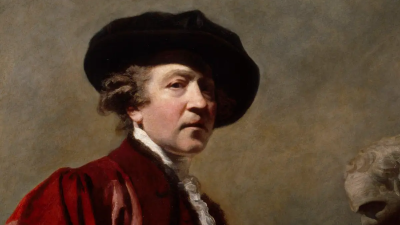
Lord Leighton PRA, Sketch model for the figure of Andromeda in 'Perseus and Andromeda', ca. 1890.
Plaster with bronze coloured paint. 310 mm x 120 mm x 115 mm, Weight: 925 g. © Photo: Royal Academy of Arts, London.
This image is not available to download. To licence this image for commercial purposes, contact our Picture Library at picturelibrary@royalacademy.org.uk
Sketch model for the figure of Andromeda in 'Perseus and Andromeda', ca. 1890
Lord Leighton PRA (1830 - 1896)
RA Collection: Art
On free display in Collection Gallery
In Greek legend, Queen Cassiopeia angered the sea god Poseidon by claiming that she (or in some versions her daughter Andromeda) was more beautiful than the Nereids. As punishment Poseidon sent a sea monster to attack her land. The only way that the monster could be averted was by chaining Andromeda to a rock in the sea as a sacrifice. Perseus saw the abandoned Andromeda as he travelled by on his winged horse and came to her rescue by slaying the monster.
This plaster study is a model for the figure of Andromeda in Leighton's 1891 painting 'Perseus and Andromeda' (Walker Art Gallery, Liverpool). In this painting Leighton depicted the vital moment when Perseus saved the princess. The strained contortion of Andromeda's body, typical of Leighton's late paintings and sculpture, was greatly admired by critics when the painting was exhibited at the Royal Academy in 1891. Unlike the plaster figure, which would not have been viewed outside Leighton's studio, the painted figure of Andromeda was partially draped.
In an interview in The Studio (1893, p. 7) Leighton explained the role that his small sculptural studies played in the composition of his paintings:
‘“these models are clad with real drapery wetted to increase the effect of its fineness in proportion to the small scale of the folds” and are made only for the sake of ten minutes drawings, the serious study of the drapery being made from the living model or the lay figure. They help also to facilitate the disposition of the grouping, but are done with as soon as the cartoon is ready for tracing.’
This group includes tracings, drawings and a sketch model, all preparatory studies for two of Leighton's paintings based on the same myth, 'Perseus and Andromeda' (ca. 1891, Walker Art Gallery, Liverpool) and 'Perseus on Pegasus Hastening to the Rescue of Andromeda' (ca. 1895-6, Leicestershire Museums).
In Greek myth, Andromeda was the daughter of King Cepheus and Queen Cassiope of Ethiopia. When the Queen boasted that Andromeda was more beautiful than the Nereids (the daughters of a sea god, Nereus), Poseidon retaliated by sending floods and a sea-monster to attack Ethiopia. Eventually, in order to placate the creature, Cepheus and Cassiope were forced to sacrifice their daughter. Andromeda was chained to a rock but she was rescued by Perseus before the monster could reach her.
Three of the studies, two drawings and a sketch model for the first painting 'Perseus and Andromeda' reveal Leighton's preparatory work for the complex, twisting female figure. He returned to the same myth several years later with 'Perseus on Pegasus Hastening to the Rescue of Andromeda'. This composition omitted Andromeda altogether to focus entirely on Perseus on the winged horse above a rocky coastal landscape.
Object details
310 mm x 120 mm x 115 mm, Weight: 925 g
Start exploring the RA Collection
- Explore art works, paint-smeared palettes, scribbled letters and more...
- Artists and architects have run the RA for 250 years.
Our Collection is a record of them.



